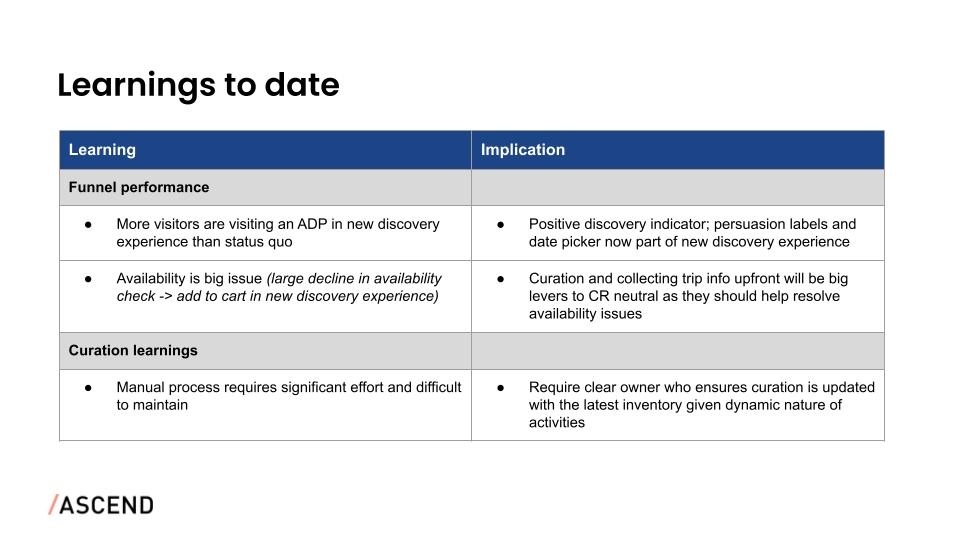
Buy-in is the lifeblood of Product Management. I learned this the hard way. As a new PM, I walked into my first roadmap planning meeting confident and excited. I was about to recommend that we build a new search feature, and I knew it was a slam-dunk idea.
As I shared my recommendation with the product team, I was met with confused stares and irritated faces. After I was done, I was peppered with questions and comments: “Why should we prioritize this over another feature that’s easier to build?” and “I don’t get why we should offer this at all.”
Yikes.
I left the meeting defeated and stressed. My team felt like I was forcing ideas on them and undervaluing their expertise.
This is a common problem, and one you can learn how to fix. I’ll let you in on the painfully obvious secret: Buy-in is the result of showing your team why your idea achieves their goals. It sounds trite, but it’s true.
In practice, however, it is difficult to do. In fact, over the years, I’ve realized there are three common reasons leaders fail to get buy-in. In this case, I was guilty of all three:
- Assuming everyone is thinking what you’re thinking. We assume the “right answer” must be obvious, but it almost never is.
- Feeling time-crunched. We believe there isn’t enough time to get everyone fully bought in before you have to move forward.
- Fear of disagreement. We’re afraid someone will dissent, so we try to sneak the plan through. Sometimes we do this subconsciously, and we aren’t even aware of this fear!
To avoid these pitfalls, I’ll share the three tactics that I’ve found to have the largest impact on getting buy-in:
- Co-creation
- Presence
- Storytelling
1. Co-creation
If you co-create your idea with your team, your team will be infinitely more receptive to your suggestions. Co-creation means collaborating with others to identify the best solution or plan of action.
Co-creation is important for two reasons:
- First, you create a better idea. Every day, you work with smart people with diverse perspectives. Leverage that! You don’t need to come up with the best idea; you need to execute on the best idea.
- Second, when you co-create, people feel invested in the idea, so they have a stake in the outcome.
After my failed attempt to rally my team around the feature I thought we should prioritize, I changed my approach and co-created with them. I walked them through the data, and we aligned on which part of the funnel had the biggest opportunity to improve conversion. They saw what I saw.
We then brainstormed potential features and concluded, as a team, that we should prioritize building an improved search feature. In the end, we had a better solution than the one I initially proposed and everyone was bought in.
You can co-create in practically any scenario: aligning with your team on quarterly OKRs, aligning with stakeholders on project status, asking for resources from a cross-functional partner, gaining support for your recommendation, or keeping a meeting on track.
Three strategies to co-create effectively:
1. Start early.
It’s so common to start working on a project and do everything yourself before talking to others. This is shortsighted! Again, your goal isn’t to come up with a great idea; it is to execute on a great idea. So once you have a straw-man proposal to tackle a problem, bring together the group that’s affected. Run a brainstorming session to jointly iterate on the draft proposal and align on what success looks like. That will get everyone’s brain churning and help you co-create. Stakeholders will feel valued. You’ll stop hearing “I wish you’d looped us in earlier.”

2. Show your work while you work.
Remember math class where your teacher would require you to show the process of solving the problem, instead of just writing down the solution? Take “show your work” one step further. As you are coming up with ideas and thinking through the problem, get used to sharing updates along the way. You can do this by dropping a summary of user interview results in Slack or sharing learnings and challenges in casual conversations in between meetings or formal weekly check-ins.

I used to share a slide like this to highlight key learnings and the associated conclusions with the working group and executives.
3. Be curious.
It’s easy to mentally write off a stakeholder who expresses concerns about your idea. You may think, “They just don’t get it.” This gets you nowhere. Invest the time to understand people’s concerns and motivations. Ask open-ended questions to gain insights to create a compelling pitch. Questions include:
- “What am I missing?”
- “How can we make this stronger?”
- “Can you please walk us through your thinking?”
2. Presence
Presence is an elusive trait. We know it when we see it. It’s our ability to own the room. The Harvard Business Review describes it as “your ability to project mature self-confidence; a sense that you can take control of difficult, unpredictable situations, make tough decisions in a timely way, and hold your own with other talented and strong-willed team members.”
Presence is important because it shapes how colleagues perceive us. This impacts our ability to influence.
Presence is a combination of verbal cues, body language, and mindset. One of the actions you can take to improve your presence is to stop saying “sorry” when it’s not warranted. Our words impact how stakeholders perceive us and how we perceive ourselves. Instead of apologizing, say the following phrases:
🙈 Instead of: “Sorry to bother you”
💪 Say: “Do you have a minute?”
🙈 Instead of: “Sorry, I messed up”
💪 Say: “I’ll fix that now”
🙈 Instead of: “Sorry, I didn’t realize”
💪 Say: “Thanks for pointing that out”
🙈 Instead of: “Sorry, I didn’t understand”
💪 Say: “Can you help me understand?”
Natalie, a senior engineer at Salesforce, realized she said “sorry” all the time when we were discussing this in Arise Leadership Accelerator. She practiced not saying it as her default response. Within a week, her team commented that she presented more compelling ideas and showed up stronger. A seemingly simple change can have a powerful impact.
In addition, own your voice by getting rid of qualifiers like “actually,” “quickly,” or “just.” For example: “I actually have an idea,” “I just think that…” or “I have a quick question.”
- “Just” demeans what you have to say. It shrinks your power and influence.
- “Actually” communicates a sense of surprise that you have something to contribute.
- “Quickly” assumes by default you’re imposing on others.
Don’t minimize yourself. Trust yourself—share your ideas and ask the questions.
3. Storytelling
One big reason we fail to get buy-in is that we assume everyone else is thinking what we’re thinking. Storytelling helps break through this roadblock.
Good storytelling means you present a narrative that resonates with your audience.
Focus on why stakeholders should care about the idea. For example, prioritizing a recommendation feature will improve conversion or changing the sprint process will free up time to reduce tech debt.
When you present your message, cut the backstory to prevent meeting attendees from zoning out. Ask yourself: What context does the stakeholder need to know to make a decision? Eliminate everything else (or put it in the appendix). You can always share more information if needed.
Reflect on these questions to help you craft a streamlined meeting agenda:

To drive alignment, always focus on co-creating, showcasing presence, and storytelling. It’s an ongoing process. The more you practice, the more natural it will get. Influencing is the best way to drive a larger impact at your company and move up faster in your career. Good luck and happy influencing!
This article was originally posted in Lenny Rachitsky’s newsletter as a guest post.
Arise Leadership was formerly known as Ascend.

